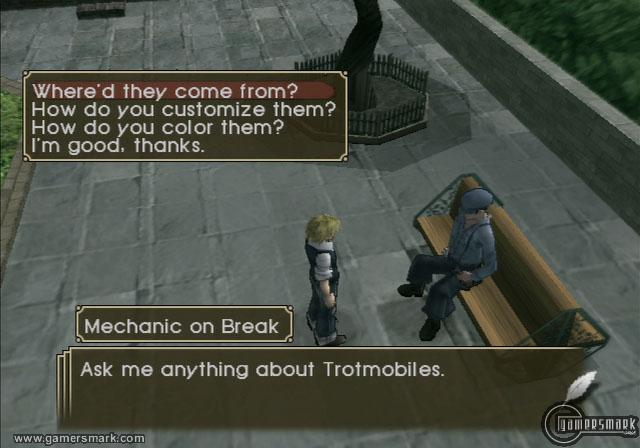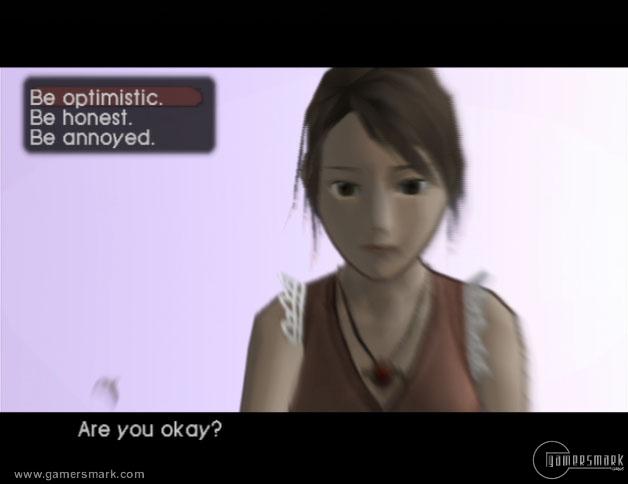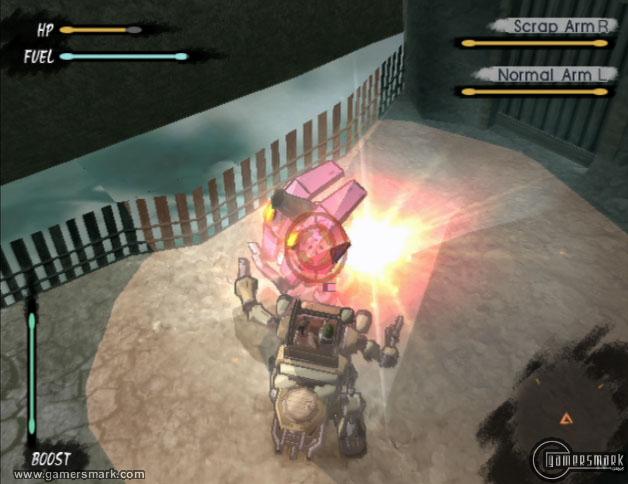Developer: Irem / Publisher: Atlus || Overall: 7.5/10
Atlus is known for delivering niche Japanese-developed titles and Steambot Chronicles is no exception. Developed by Irem, Steambot Chronicles is not really any one type of game that you can pinpoint directly – it is one part sandbox, one part mech game, one part music game, and one part RPG all mixed into each other. Combined with its certain type of charm and fantasy, Steambot Chronicles is a great little game that is hampered by control problems, graphical inconsistencies, and a weak story to boot.
The story starts out with the main character losing his memory, as he awakens on a beach. This prompts the main character, Vanilla, to find out whom he is, and what happened. Even though there is a huge ship that has crashed against the shore and smoking because of a fire, there is little to no acknowledgement of it by you or the person who found you, named Connie, which is a little weird to say the least. Given that the story is very simplistic in nature to begin with, its immediately apparent that Steambot Chronicles is really not about its story as you get into some real gameplay with little to no delay.
The girl who finds you on the beach, Connie, is a cute brown-haired girl who sings for a very famous band called the Garland Globetrotters., and if you play your cards right a nice relationship can evolve from knowing her. Constantly throughout the game, you are given choices for what Vanilla says or does, and the outcome of certain events will be influenced by such. You can be a bastard or a big softy – it’s really up to you. The very weak story of Steambot Chronicles basically encompasses Vanilla’s search for who he is while going on tour with Connie’s band. Other than that it really isn’t compelling – the world doesn’t have to be saved, there is no impending evil; you get the point. Along the way you’ll meet up with many people and discover new things to do in the world. The game itself is very non-linear and you don’t even have to follow through with the story at all except for a few key parts. An interesting way that the game influences you to try and talk to everyone in towns and cities is that their picture is added to a photo album in the start menu. This is very unique, to say the least, and gives you a feeling of “talk to all the generic characters I can find!” Pictures will be updated as you talk to more and more people, and important characters will get their own picture.
The main form of transportation and gameplay is something called a trotmobile. Think of a car with arms and legs and you have a trotmobile. Anyone who has played through Front Mission 3 or 4 will instantly grasp how to manage it in the backend system. Basically, a trotmobile’s body/legs can hold a certain amount of wight which will contribute to what kind of arms and “backpack” you can equip. Arms are mainly used for combat while the back attachment is more for the extra stuff you can do in the world. Possible types of arms include Sword Arms, Spiked Ball Arms, Cannon Arms and back attachments include a carriage for bussing people around and a flatbed for carrying stuff. This is all fine and dandy except for two very disappointing aspects of the game.
The controls for the trotmobile are very counter-intuitive because they use “Katamari” controls. Both analog sticks are required to move effectively which quite frankly blows because it doesn’t give you a free camera (you’re locked behind your trotmobile at all times) to use. This is very annoying when battling, obviously. Not to mention that movement would have been done just as effectively, if not more, with one stick. The other glaring problem is that there just isn’t that much actual combat to spend time on. Without any random battles, you’re forced to fight the same enemies over and over – they’ll pop out at you from the same place as you travel between towns.
Trotmobiles are also very slow, so you’ll be walking through fields, beating two enemies between each town (effortlessly, I might add) without getting much use of the effort you put into improving your trotmobile to begin with.
Boss battles happen every once in a while and are very fun, but they only last for maybe a minute or two before you’re given a load time to celebrate your win. Each town has their own “Arena” in which you can fight tough trotmobiles 1 on 1, but even these battles go by quickly. There’s almost as much loading as there is playtime (sometimes more if you’re good) during these Arena battles. Other things in the world to do include playing an assortment of instruments for different songs, bussing people from one town to the next, fighting in arenas and dungeons, digging up fossils to fill up a museum, and stuff like that. You’re allowed to do almost anything you please in the world that has been created. You’ll also have to maintain your character by eating whenever he gets hungry, and that’s just plain annoying.
As for sound and graphics, they are about average. The voice actors are alright but they can be annoying at times. General sound effect usage is good, and battle sounds aren’t very irritating even though you hear them over and over. The most bothersome sound effect would be the trotmobile’s walking noise. Music is very cheerful, and goes along with the mood of the game, but isn’t all that memorable. As for the graphics, the game has a cel-shaded look to it which promotes a cartoonish feel to the game – but maintains a more realistic look than most cel-shaded games. There isn’t anything special but nothing is particularly ugly except a few things that stick out like character animation. Load times also avert some of the pleasure that is delivered, which is unfortunate.
What I favored about this game was the open-endedness of it all. The game doesn’t tell you where to go; you tell the game where to go. It shows that GTA-style games don’t always have to be about 100% action or even have a strong storyline; it provides the person playing the game with many things to do at their own leisure with practically no bounds. By giving you choices in what to say or do throughout the game, it can also influence you to replay the game and see how it would be being mean the whole way through or being nice all the time.
Steambot Chronicles is a fun game that rides on you being interested enough to take part in the activities the world offers through its non-linearity. Besides the flawed controls and graphical discrepancies here and there, Steambot Chronicles is a light-hearted adventure game that isn’t hard to get into.



